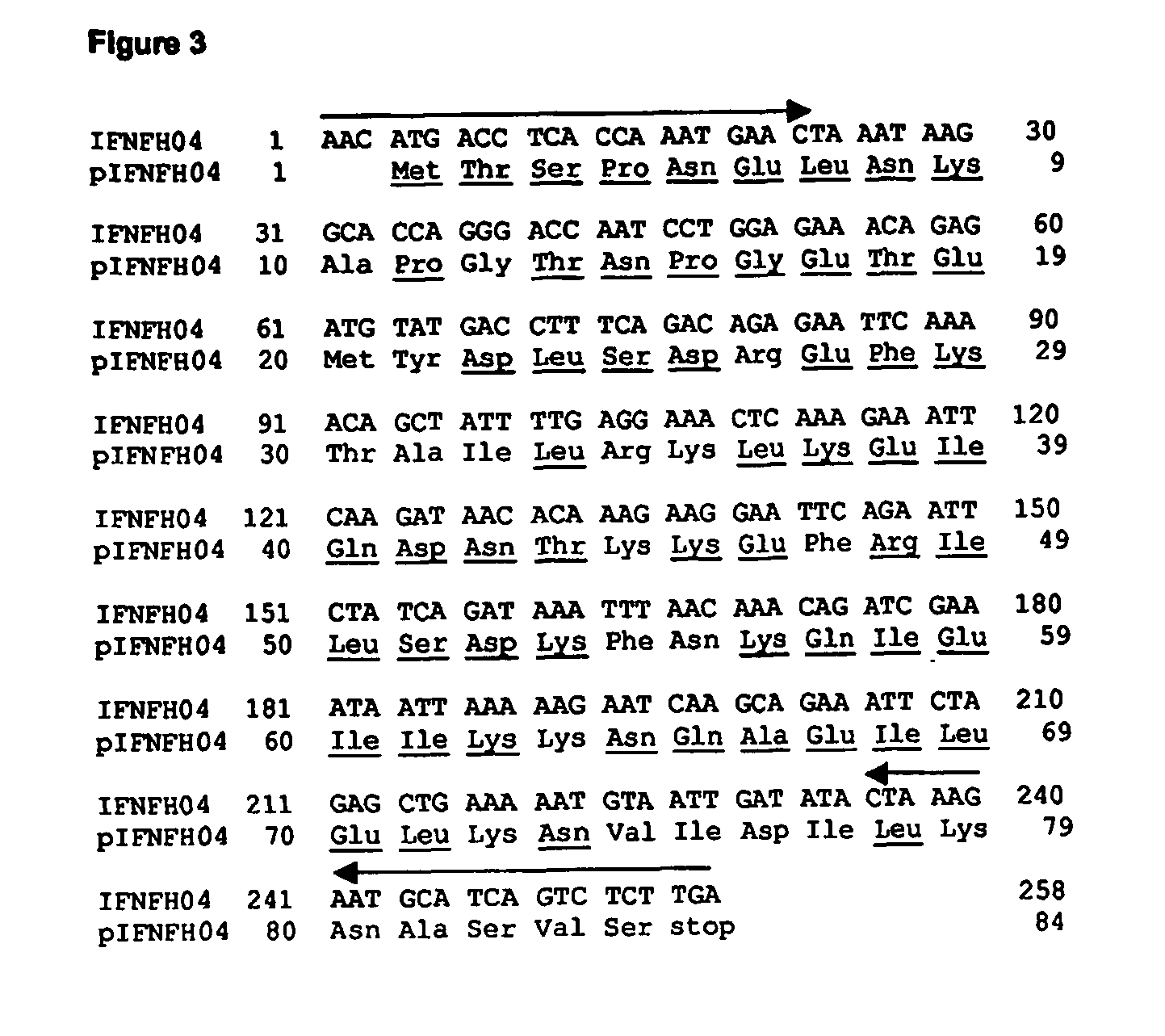Novel IFNgamma-like polypeptides
a polypeptide, ifngamma technology, applied in the preparation of peptides, depsipeptides, peptide/protein ingredients, etc., can solve the problems of neurotoxicity, fever, fatigue, nausea, and significant side effects, and achieve the effect of diagnosis, prevention and treatmen
- Summary
- Abstract
- Description
- Claims
- Application Information
AI Technical Summary
Benefits of technology
Problems solved by technology
Method used
Image
Examples
example 1
Selection of Open Reading Frames (ORFs) Encoding for Polypeptides Homologous to INSP037, Called pIFNFHs
[0133] INSP037 was identified as an IFNgamma-like protein encoded by an ORF in human genome (GB patent application No. 0130720.6). The sequence of this ORF was used to search for homologous ORFs in human genome (Celera and GenBank databases). The homology was detected using the BLAST (Basic Local Alignment Search Tool; NCBI version 2), an algorithm which generates local alignments between a query and a hit sequence (Gish W and States D J, 1993; Pearson W R and Miller W, 1992; Altschul S F et al., 1990). In this case the TBLASTN algorithm was used with the INSP037 protein sequence as a query. TBLASTN compares the query sequence to the database translated into 6 frames and can therefore identify a protein match to a DNA sequence in any reading frame. BLAST parameters used were: Comparison matrix=BLOSUM62; word length=3; .E value cutoff=10; Gap opening and extension=default; No filte...
example 2
Cloning of the IFNFHs Nucleic Acid Sequences from Human Genomic DNA
[0144] The selected IFNFH nucleic acid sequences, each corresponding to a single axon, were cloned (with the exception of IFNFH25) from human genomic DNA into a cloning vector, and then transferred into an expression vector using Polymerase Chain Reaction (PCR), with pairs of forward / reverse primers specific for each ORF (see arrows in FIGS. 1-12 and 14-20).
[0145] The cloning primers (CL series; SEQ ID NO: 41-78, Table III), containing from 21 to 30 nucleotides, were designed for amplifying each ORF using human genomic DNA as template, since all ORFs are uninterrupted on human chromosomes. The forward primers start from three nucleotides before initial ATG. The reverse primers are complementary to the 3′ end of the ORF, including the stop codon. Being the N-terminal sequences very similar amongst the different IFNFHs, the reverse primers actually are actually responsible for the specificity of the amplification rea...
example 3
Expression and Purification of the His-Tagged pIFNFHs Polypeptides in Mammalian Cells
[0189] The vectors generated in Example 2 were used to express pIFNFHs in Human Embryonic Kidney cells expressing the Epstein-Barr virus Nuclear Antigen (cell line HEK293-EBNA).
[0190] The cells were seeded in T225 flasks (50 ml at a density of 2×105 cells / ml) from 16 to 20 hours prior to transfection, which was performed using the cationic polymer reagent JetPEI™ (PolyPlus-transfection; 2 μl / μg of plasmid DNA). For each flask, 113 μg of the ORF-specific pEAK12D plasmid, which were prepared using CsCl (Sambrook, J et al. “Molecular Cloning, a laboratory manual”; 2nd edition. 1989; Cold Spring Harbor Laboratory Press), were co-transfected with 2.3 μg of a plasmid acting as positive control since it expresses Green Fluorescent Protein (GFP) in a constitutive manner. The plasmids, diluted in 230 μl of JetPEI™ solution, were added to 4.6 ml of NaCl 150 mM, vortexed and incubated for 30 minutes at room ...
PUM
| Property | Measurement | Unit |
|---|---|---|
| Fraction | aaaaa | aaaaa |
| Volume | aaaaa | aaaaa |
| Volume | aaaaa | aaaaa |
Abstract
Description
Claims
Application Information
 Login to View More
Login to View More - R&D
- Intellectual Property
- Life Sciences
- Materials
- Tech Scout
- Unparalleled Data Quality
- Higher Quality Content
- 60% Fewer Hallucinations
Browse by: Latest US Patents, China's latest patents, Technical Efficacy Thesaurus, Application Domain, Technology Topic, Popular Technical Reports.
© 2025 PatSnap. All rights reserved.Legal|Privacy policy|Modern Slavery Act Transparency Statement|Sitemap|About US| Contact US: help@patsnap.com



